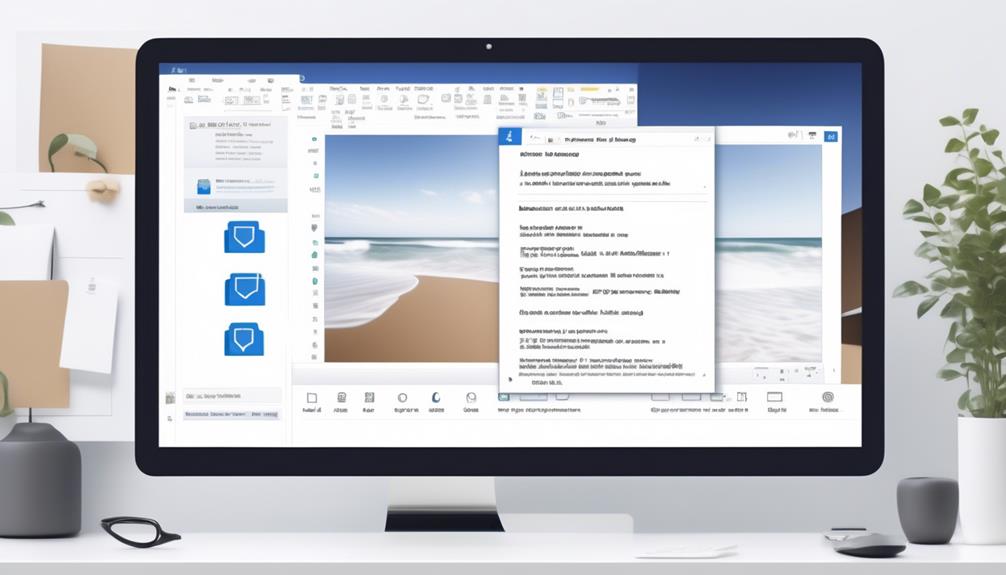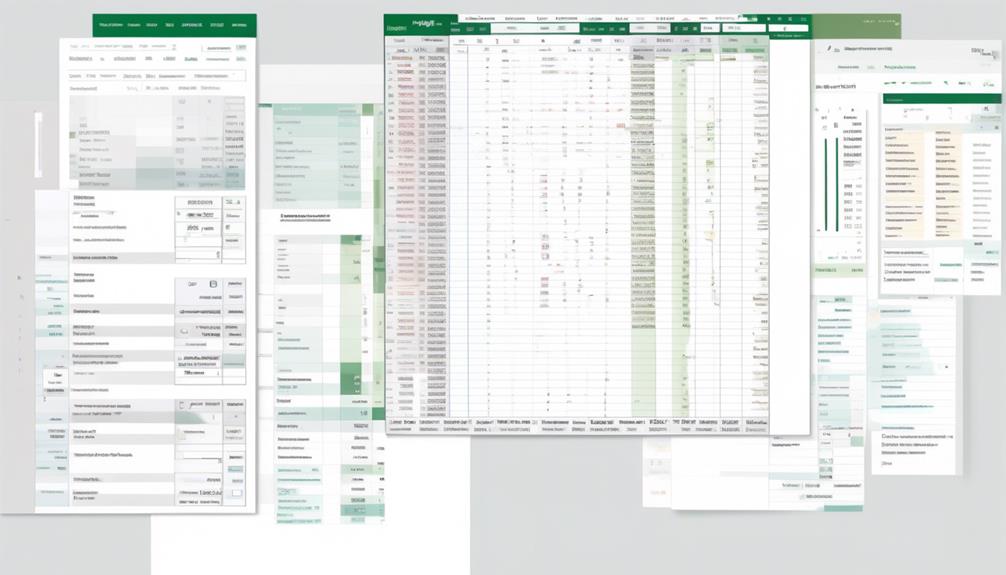We have all experienced the frustration of receiving a deluge of unwanted commercial email (UCE) or unsolicited bulk email (UBE), clogging up our email inboxes. The sheer volume and potential risks associated with these unwanted emails have become a major concern for both individuals and businesses.
But what exactly are the implications of these messages, and how can we effectively address this pervasive issue? Let's explore the impact of UCE and UBE messages on email communication, the legal landscape surrounding them, and the evolving strategies for mitigating their effects.
Key Takeaways
- UCE/UBE messages make up a significant portion of email traffic, accounting for approximately 90% of all emails.
- These messages often contain malicious links or attachments, posing a threat to the security and privacy of email users.
- UCE/UBE messages not only cause disruptions and delays in email delivery but also deceive recipients into providing personal or financial information, leading to potential identity theft and financial loss.
- Businesses and ISPs face numerous challenges in dealing with UCE/UBE messages, including the overload of email servers, potential reputation damage, and the global nature of the issue. Collaborative efforts are crucial in addressing these challenges effectively.
The Definition of UCE and UBE
Defining UCE and UBE is essential for understanding the impact of unsolicited commercial email on email users and the measures taken to combat it.
Unsolicited commercial email (UCE) and unsolicited bulk email (UBE) are commonly known as spam and make up approximately 90 percent of all email traffic. UCE/UBE messages are estimated to be fraudulent in content or packaging in about one-fourth of all cases. These messages often contain malicious links or attachments, posing a significant nuisance for email users.
Legal and regulatory measures, such as 'Do Not Email' registries and fines for violators, have been enacted to combat UCE/UBE messages. Additionally, technological solutions like email filters, anti-spam software, and security updates help mitigate the impact of UCE/UBE messages.
UCE and UBE are detrimental to the efficiency and security of email communication, making it crucial to have a clear understanding of these terms and their implications. With such a pervasive issue, it's imperative to stay informed and take proactive measures to combat the influx of UCE/UBE messages.
Impact on Email Communication

The prevalence of UCE and UBE messages not only disrupts email communication but also poses serious threats to the security and efficiency of online interactions. Unsolicited commercial email (UCE) and unsolicited bulk email (UBE) messages overload email servers and networks, causing delays and disruptions for internet users. These messages can deceive recipients into providing personal information or financial details, leading to potential identity theft and financial loss. Moreover, they can negatively impact the reputation and trustworthiness of legitimate businesses, affecting their operations and consumer confidence.
To convey a deeper understanding of the impact of UCE and UBE messages, the following table outlines the effects on email communication:
| Impact on Email Communication | Description |
|---|---|
| Overloads email servers and networks | Causes delays and disruptions for internet users |
| Poses security risks | Deceives recipients into providing personal information or financial details, leading to potential identity theft and financial loss |
| Affects business reputation | Negatively impacts the reputation and trustworthiness of legitimate businesses, affecting their operations and consumer confidence |
To combat these issues, users can utilize spam filters, email settings, and regularly update antivirus software to protect against UCE/UBE messages and minimize their impact. Additionally, the development of artificial intelligence (AI) and machine learning algorithms aims to improve spam detection and enhance protection against UCE/UBE messages.
Legal Regulations and Compliance
Implementing effective legal regulations and compliance measures is essential in combating the prevalence of unsolicited commercial email (UCE) and unsolicited bulk email (UBE) messages. Legal regulations in many countries require prior consent for sending commercial emails and impose fines for violations.
Compliance involves adherence to measures such as 'Do Not Email' registries and international cooperation to address the global nature of UCE/UBE messages. Technological solutions, including email filters, spam detection algorithms, and anti-spam software, play a crucial role in compliance with legal regulations and protection against UCE/UBE messages.
The impact of UCE/UBE messages on the internet economy can be significant, damaging the reputation of businesses and leading to financial losses from phishing scams. To combat UCE/UBE messages effectively, advancements in artificial intelligence and sender authentication technologies are being pursued, along with collaborative efforts between industry stakeholders and law enforcement agencies.
As the fight against UCE/UBE messages continues, staying abreast of and complying with legal regulations is crucial for businesses and individuals to mitigate the impact of unsolicited commercial email.
Techniques for Filtering UCE and UBE

Utilizing email filters and spam detection algorithms is essential for automatically identifying and blocking UCE/UBE messages. These tools can be customized to move UCE/UBE messages to spam folders, minimizing their impact on regular communication.
In addition, anti-spam software and email security solutions offer an extra layer of protection against UCE/UBE messages. Regularly updating software and security patches is crucial to mitigate vulnerabilities exploited by UCE/UBE messages.
Furthermore, the use of machine learning and artificial intelligence can enhance the accuracy of identifying and filtering UCE/UBE messages. By leveraging these advanced technologies, businesses and individuals can significantly reduce the influx of unsolicited commercial email and unsolicited bulk email, thereby safeguarding their inboxes and network systems.
It's important to stay informed about the latest filtering techniques and to implement comprehensive strategies that combine different tools and approaches for optimal UCE/UBE message management. With a proactive and multi-faceted approach, the impact of unsolicited commercial email and unsolicited bulk email can be effectively minimized.
Challenges for Businesses and ISPs
Moving from the techniques for filtering UCE and UBE, we encounter the significant challenges faced by businesses and ISPs in combatting the influx of unsolicited commercial email and unsolicited bulk email messages.
The volume of UCE/UBE messages overwhelms email servers and networks, leading to the consumption of valuable bandwidth and storage capacity. This not only impacts the operational efficiency of businesses but also hinders the smooth functioning of ISPs.
Moreover, UCE/UBE messages pose a substantial threat to the reputation and trustworthiness of legitimate businesses, potentially resulting in financial losses and impeding the growth of e-commerce activities.
Despite the presence of laws and regulations in many countries, the global nature of UCE/UBE messages presents a complex challenge for businesses and ISPs in enforcing compliance and preventing these messages from reaching their intended recipients.
Therefore, it's imperative for industry stakeholders and law enforcement agencies to collaborate closely in order to effectively address these challenges and mitigate the adverse effects of unsolicited commercial email and unsolicited bulk email on businesses and ISPs.
Effects on User Experience

Receiving unsolicited commercial emails can have a significant negative impact on our user experience.
These messages can erode our trust in online communications and make us more wary of potential security threats.
It's important to address these issues in order to protect our online safety and maintain a positive user experience.
Negative Impact on Users
Unsolicited commercial emails, commonly known as UCE or UBE messages, can significantly disrupt the user experience, leading to frustration and decreased productivity. The negative impact on users includes:
- Inundation: Users are bombarded with a high volume of unsolicited emails, making it difficult to find and prioritize important emails.
- Security Concerns: Unsolicited emails often contain malicious links or attachments, posing a security risk to users and their devices.
- Loss of Trust: Receiving irrelevant or unwanted emails can erode users' trust in the email platform and the businesses associated with the unsolicited commercial email.
These factors contribute to a diminished user experience, affecting efficiency and overall satisfaction with the email service. Implementing effective measures to combat unsolicited commercial email is crucial in mitigating these negative impacts on users.
Trust and Security Issues
Trust and security issues significantly impact the user experience when dealing with UCE/UBE messages. Unsolicited commercial email and unsolicited bulk email can lead to increased skepticism and caution among users, affecting their trust in legitimate communications. Security concerns stemming from these messages can result in decreased user confidence and satisfaction with email platforms and digital communications.
The presence of UCE/UBE messages can create a sense of vulnerability and unease for users, influencing their overall perception of online safety and security. Dealing with the effects of UCE/UBE messages can lead to frustration and dissatisfaction, negatively impacting the overall user experience.
It's crucial for users to be vigilant and for businesses to implement robust security measures to address these trust and security issues, ensuring a safer and more positive user experience.
Prevention and Mitigation Strategies

We can effectively mitigate the risks of unsolicited commercial email (UCE) or unsolicited bulk email (UBE) messages by implementing spam filters and email security measures. To prevent and mitigate the impact of UCE/UBE, we should consider the following strategies:
- Use Spam Filters and Email Security Measures
- Implement robust spam filters to automatically detect and block UCE/UBE messages.
- Utilize email security measures such as encryption and authentication protocols to safeguard against unauthorized access and phishing attempts.
- Regularly update antivirus software to protect against malware that may be contained in UCE/UBE messages.
- Educate Users about Risks and Warning Signs
- Provide comprehensive training to users about the risks associated with UCE/UBE messages and educate them on how to identify warning signs of potential threats.
- Promote a culture of vigilance and encourage proactive reporting of suspicious emails to the IT security team.
- Exercise Caution with Unsolicited Messages
- Advise users to exercise caution when dealing with unsolicited messages to prevent falling victim to scams and identity theft.
- Emphasize the importance of refraining from clicking on links or opening attachments in unsolicited messages to mitigate the associated risks.
Emerging Technologies for UCE and UBE

We can explore advanced spam filters that utilize machine learning and artificial intelligence to improve accuracy in identifying and blocking UCE/UBE messages.
Additionally, sender authentication technologies and blockchain exploration are emerging as potential tools in combating UCE/UBE messages.
These technologies show promise in enhancing email security and reducing the impact of UCE/UBE on legitimate businesses.
Filtering UCE and UBE
Using advanced spam detection algorithms and email filters has become essential for effectively filtering out UCE and UBE messages.
- Advanced spam detection algorithms employ machine learning and artificial intelligence to analyze email content, sender reputation, and user behavior, enabling accurate identification and blocking of UCE and UBE messages.
- Email filters, including Bayesian filters and heuristic filters, examine various attributes such as sender information, message content, and attachment types to categorize and divert potential UCE and UBE messages away from users' inboxes.
- Collaborative filtering techniques leverage collective user input and feedback to enhance the accuracy of UCE and UBE message identification, allowing for the continual improvement of filtering mechanisms.
These technologies play a crucial role in safeguarding against the inundation of unsolicited commercial email and bulk email, preserving network resources and protecting users from potential security threats.
Sender Authentication Techniques
Implementing advanced sender authentication techniques is vital in combatting the infiltration of unsolicited commercial email and bulk email. It enhances email security and fortifies defenses against potential phishing attempts.
Sender authentication techniques, such as SPF, DKIM, and DMARC, play a crucial role in verifying the legitimacy of email senders and preventing email spoofing. By employing these methods, organizations can significantly reduce the delivery of fraudulent or deceptive UCE/UBE messages, thereby improving email trustworthiness.
These techniques not only help in filtering out unwanted emails but also contribute to the overall protection of recipients from malicious phishing attempts.
As technology continues to evolve, staying abreast of the latest sender authentication techniques is essential for maintaining robust email security and safeguarding against the threats posed by unsolicited commercial email and bulk email.
Future Outlook and Trends

The future outlook and trends in UCE/UBE messages are being shaped by advancements in technology and ongoing collaborative efforts to combat unsolicited commercial email.
As we look ahead, several key developments are influencing the landscape of UCE/UBE messages:
- Impact of Artificial Intelligence and Machine Learning: The use of AI and machine learning algorithms is revolutionizing spam detection and filtering, enabling more accurate identification and blocking of UCE/UBE messages.
- Sender Authentication Technologies: The implementation of sender authentication protocols such as SPF, DKIM, and DMARC is gaining momentum, providing effective means for verifying the legitimacy of email senders and reducing the prevalence of fraudulent UCE/UBE.
- Exploring Blockchain Technology: There's growing interest in leveraging blockchain technology to establish transparent and secure communication channels, potentially offering a robust solution for mitigating UCE/UBE messages through decentralized and tamper-resistant systems.
These trends reflect a concerted effort to adapt to evolving tactics employed by senders of unsolicited commercial email, demonstrating a commitment to staying ahead of the curve in the ongoing battle against UCE/UBE messages.
How Can I Avoid Sending Unsolicited Commercial Emails and Increase Engagement with Personalized Emails?
To avoid sending unsolicited commercial emails and enhance engagement, it’s essential to personalize emails for engagement. Tailor your messages based on recipient interests, previous interactions, and demographics to make them feel more relevant and valuable. By crafting personalized email campaigns, you can foster stronger connections, increase open rates, and improve overall engagement with your audience.
Frequently Asked Questions
Is an Unsolicited Commercial Email or Unsolicited Bulk Email Messages?
We understand the importance of identifying unsolicited commercial email or unsolicited bulk email messages. These types of messages can have serious implications for email servers, networks, and users.
It's crucial to address these issues effectively to protect against phishing attempts and other cyber threats. Implementing technological solutions and adhering to regulations can help combat these messages and safeguard businesses and individuals from potential harm.
What Is the Difference Between UBE and Uce?
When distinguishing between UBE and UCE, UBE refers to unsolicited bulk emails, sent in large quantities without consent.
UCE, on the other hand, stands for unsolicited commercial emails, which are unauthorized promotional messages.
The key difference lies in the nature of the content, where UBE focuses on mass distribution and UCE emphasizes commercial promotion.
Understanding these distinctions is crucial for effective identification and management of unwanted emails.
What Is Considered Unsolicited Bulk Email Ube?
Unsolicited Bulk Email (UBE) refers to the mass distribution of emails to recipients who haven't specifically requested them. It often involves sending out large volumes of identical or similar messages, inundating inboxes and clogging up networks.
UBE can be a major annoyance, overwhelming email servers and consuming precious bandwidth and storage space. Additionally, it poses security risks as it may contain fraudulent content or malicious links.
What Does Spam or UCE Unsolicited Commercial Email Mean?
Spam, or UCE (unsolicited commercial email), refers to unwanted, often fraudulent, and potentially harmful emails that inundate inboxes. They consume bandwidth, storage, and pose security risks.
Our team understands the importance of combating these messages and the legal measures in place. It's crucial to stay vigilant in protecting against spam to ensure the safety and efficiency of email communication.
Conclusion
In a digital world flooded with unwanted UCE and UBE messages, we must navigate through the murky waters of spam to protect our email communication.
Just as a sturdy ship weathers a storm at sea, effective spam filters and compliance with regulations act as our protective armor.
As we sail into the future, emerging technologies will continue to steer us towards clearer skies, ensuring a smoother and safer email experience for all.









